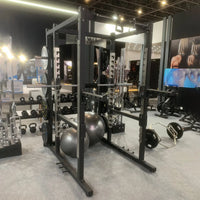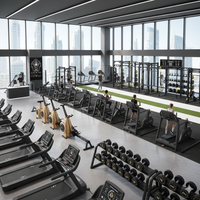Sarcopenia—the gradual loss of muscle mass, strength, and function that occurs with aging—is more than just a fitness buzzword. It's a critical health concern that dramatically impacts mobility, metabolic health, and quality of life. After the age of 30, muscle mass can decline by as much as 3–8% per decade, a rate that accelerates significantly after age 60. This loss is not merely cosmetic; it directly increases the risk of falls, fragility, and chronic disease.
The consensus among health experts is clear: the most effective, and often only, therapy to prevent and reverse sarcopenia is resistance training. But not all resistance is created equal. The heavy-duty, precisely engineered nature of Commercial Gym Equipment offers unique advantages that make it the optimal tool for older adults seeking to build and maintain vital muscle mass.
The Science of Muscle Preservation
Sarcopenia is driven by a reduction in the body’s ability to synthesize new muscle protein and a subtle, long-term shift toward muscle breakdown. To counteract this, the body needs a powerful stimulus that activates the muscle growth pathways. This stimulus is known as mechanical tension, achieved by lifting heavy weights.
The challenge for older adults is delivering this intense stimulus safely, consistently, and progressively. This is where the sheer engineering superiority of Commercial Gym Equipment—from power racks to functional trainers—becomes indispensable.
1. Precision and Isolation: Training with Safety in Mind
High-quality Commercial Gym Equipment, particularly machine-based pieces (like leg presses, lat pull-downs, and chest presses), offers stability and controlled movement that free weights simply cannot match for a deconditioned or aging body.
-
Fixed Biomechanics: Commercial machines are designed based on biomechanical principles to target specific muscle groups with minimal involvement of stabilizing muscles. This is crucial for older adults who may have joint issues or compromised balance. The fixed path ensures the right muscles are activated without unnecessary strain on tendons or ligaments.
-
Pin-Loaded Resistance: The ability to make small, incremental jumps in resistance (often as little as 5 lbs or 2.5 kg with add-on plates) is vital for the principle of progressive overload in this demographic. Unlike bulky home gym equipment, commercial machines allow for safer micro-adjustments essential for consistent, injury-free progress.
2. Progressive Overload: The Muscle-Building Imperative
To combat sarcopenia, your muscles must be continually challenged to lift a weight heavier than they are accustomed to. This is the definition of progressive overload, and it is the single most important variable for muscle hypertrophy (growth).
-
High Weight Capacity: Commercial Gym Equipment is built with heavy-gauge steel and high-load capacities, accommodating the necessary weight for substantial strength gains. A high-end squat rack or leg press in a commercial setting can safely handle weights far beyond the capacity of even the best home-grade gear.
-
Access to Variety: A commercial facility provides a wide range of dumbbells, barbells, and plates (including fractional plates), ensuring that regardless of a person’s starting strength, they can always find the precise weight needed for the next step in their progression. This constant, structured challenge is what forces the muscle to adapt and grow.
3. Superior Stability and Robust Build Quality
The heavy, often multi-thousand-pound footprints of Commercial Gym Equipment are no accident. The immense stability is a direct safety feature, particularly for movements involving the lower body.
-
Foundation for Compound Lifts: For foundational movements like squats and deadlifts, which are critical for whole-body muscle maintenance and functional strength, a heavy-duty power cage or a multi-purpose machine offers superior racking security and peace of mind.
-
Durability and Smoothness: Commercial equipment is built to withstand abuse from hundreds of users, meaning its pulleys, cables, and guide rods are significantly smoother and more durable. This smooth operation is important for joint health, preventing the jerky movements often associated with lower-quality gear.
4. Controlled Eccentric Training
Research shows that the eccentric phase of a lift (the lowering or lengthening of the muscle) is the most potent stimulus for muscle growth. For an older adult, controlling a heavy weight through the eccentric phase can be challenging, even dangerous, with unstable equipment.
The robust design and smooth resistance profile of Commercial Gym Equipment allow the user to manage heavy loads through the lowering phase with maximum control. This targeted, controlled stress maximizes mechanical tension, accelerating the physiological changes necessary to reverse muscle loss.
Conclusion: Investing in Independence
Combating sarcopenia is an investment in long-term independence. While light exercise is better than none, reversing age-related muscle decline requires real, structured resistance. Commercial Gym Equipment provides the superior tools for this essential work: the safety and precision of machines, the capacity for progressive overload, and the sheer stability required for effective, high-tension training.
For older adults, this means seeking out a high-quality gym or facility. By leveraging the power of commercial-grade resistance, you’re not just lifting weights—you are building a biological shield against frailty and securing a future defined by strength, mobility, and vitality.




0 comments